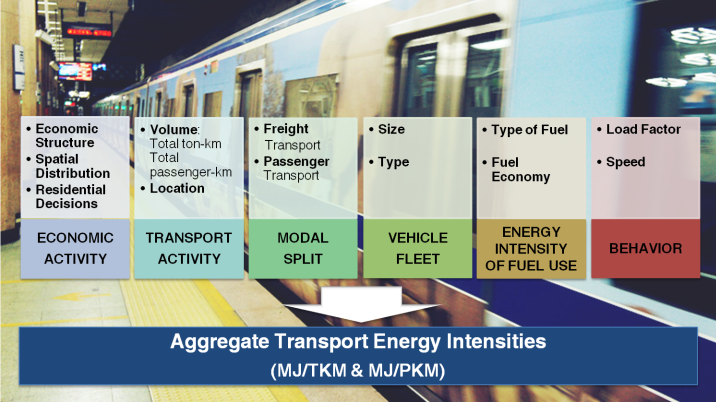Key Recommendations
There is no easy solution to reduce GHG emissions from transport: A comprehensive approach is required that simultaneously seeks to
(i) reduce the demand for total motorized transport activity through appropriately designed urban places,
(ii) promote the use of “low-emission” transport modes such as walking, cycling, and public transport, and
(iii) use the most efficient fuel-vehicle technology system possible for all trips.
Reducing CO2 emissions is a growing challenge for the transport sector. Transportation produces roughly 23 percent of the global CO2 emissions from fuel combustion. More alarmingly, transportation is the fastest growing consumer of fossil fuels and the fastest growing source of CO2 emissions. With rapid urbanization in developing countries, energy consumption and CO2 emissions by urban transport are increasing rapidly.
These growing emissions also pose an enormous challenge to urban transport in China. As a recent World Bank study of 17 sample cities in China indicates, urban transport energy use and greenhouse gas (GHG) emissions have recently grown between 4 and 6 percent a year in major cities such as Beijing, Shanghai, Guangzhou, and Xian (Darido, Torres- Montoya, and Mehndiratta 2009). The numbers could be considerably higher in 2011.
Opportunities for Low-Carbon Urban Transport
Despite the trend toward increasing emissions, opportunities exist for low-carbon urban transport development in China. Figure above provides a schematic of the drivers of emissions from urban transport and indicates entry points for urban transport policy interventions to save energy and reduce CO2 emissions.
The six entry points in figure above all relate to the fact that, in essence, GHG from transport are emitted from the fuel used on motorized trips. The figure shows that increases in the level of economic activity in a city usually result in an increase in the total number of trips; that is, the aggregate level of transport activity.
These trips are distributed across the range of available modes (referred to as the modal split), depending on the competitiveness of the alternatives for any given trip maker. Every motorized trip emits GHG emissions and the amount of emission depends largely on the amount and GHG intensity of the fuel used, or the efficiency of the vehicle fleet and the energy intensity of the fuel used. Finally, driver behavior impacts the fuel use; after certain threshold speeds, fuel consumption becomes significantly higher.
While this complex and distributed nature in which GHG emissions are generated makes transport a particularly hard sector in which to dramatically reduce emissions, there are several strategy options for a city looking to reduce the carbon foot-print of its urban transport sector, all of which are very relevant to Chinese cities today:
- Changing the distribution of activities in space: For any given level of economic activity, if a city can influence the distribution of activities in space (for example, by changing land-use patterns, densities, and urban design) it can have an impact on the total level of transport activity. Better land-use planning and compact city development can lead to fewer or shorter motorized trips and a larger share for public transport of motorized trips. Look for more information: Developing Low-Carbon Cities in China: Local Governance, Municipal Finance, and Land-Use Planning-The Key Underlying Drivers laid out the issues, structural challenges, and a way forward to address this challenge.
- Supporting low-carbon transport modes: A city can also influence the way transport activity is realized in terms of choice of modes. Look for more information: Public Transport/ Cycling /Walking in Sustainable Low Carbon City book will discuss improving the quality of relatively “low emission” modes such as walking, cycling, and various forms of public transport.
Such steps can help a city attract trip takers to these modes and lower their carbon emissions per trip. - Affecting vehicle use: Finally, a city can take a range of measures that directly influence what vehicles are being used and how much private transport is being used. Look for more information: Demand Management and Technology in Sustainable Low Carbon City book will describe two approaches to reduce emissions from motorized vehicles. One is the adoption of technological measures that reduce the carbon emissions of motorized vehicles per unit of travel. The other is the adoption of demand management measures that would reduce the amount of automotive travel. This includes both non-pricing controls on vehicle ownership and use (for example, restrictions on parking or days the car can be used), and pricing controls such as fuel taxes, higher parking fees, and congestion pricing
Experience internationally and in China suggests that there is no easy solution to reduce GHG emissions from transport. A comprehensive approach is required that simultaneously seeks to (i) reduce the demand for total motorized transport activity through appropriately designed urban places; (ii) promote the use of “low-emission” transport modes such as walking, cycling, and public transport; and (iii) use the most efficient fuel-vehicle technology system possible for all trips. While cities will need to find the right mix of strategies to suit their particular circumstances, the following general approaches apply: As cities grow in population and expand their spatial footprint, perhaps their most important priority is to ensure that their spatial footprint is compatible with strong, competitive public transport. - As incomes increase, creating viable alternatives to the use of cars for those who have a choice will be absolutely critical in almost all of China’s cities to keep them livable and functioning efficiently. For the larger cities, actively managing automobile use will increasingly be a necessary option to consider and develop.
- Technology will need to complement these two fundamental strategies—and in that role can provide significant GHG reductions and other related environmental benefits.


